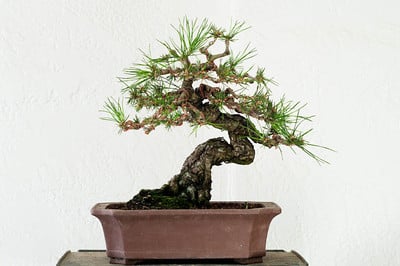I recently learned, a bit late, how to treat black pines that were decandled in fall – see “Fall decandling, year two” for details. After decandling the tree, I took the opportunity to wire it in a workshop with Akio Kondo. After reviewing my wiring, Kondo asked if I had a toothbrush. Too soft, he said. I offered a nylon brush with bristles I’d shortened for cleaning juniper bark. Perfect. Kondo took the brush and began gently brushing the tops of the branches. He says the gentle stimulation will encourage new buds.

Brushing the bark
I quickly brushed the remaining branches and began looking forward to learning what will happen when the tree buds out next month.
The wiring, Kondo noted, is not for styling. It’s sole purpose is to expose the interior branches to the light. A few years down the road, when new shoots become large enough to wire, it will be time for a proper styling.

After wiring
At this point, I’m simply hoping for enough warm weather to coax some summer growth out of the tree.
Subscribe to Bonsai Tonight
New Posts Delivered Every Tuesday and Friday
gaycarboys says
Aready a gorgeous tree.in my opinion. Just to confirm, what time of year should the brushing be done? I understood pines wouldn’t bud past the current bud line on the branch. Is is possible to stimulate growth there do you think?
Mark says
Be careful not to conclude that brushing really makes a difference, based solely on this one case. Or even a few of them. To be able to confidently support that theory (or shall we say – myth), one should apply the procedure on a statistically significant number of trees including the control ones (not brushed) over several years.
xwires says
Thanks Mark, I completely agree. Although I received the information on good authority – Kondo is a Kokufu-winning bonsai professional – I have no idea what the effect will be.
Alan – I think the best time to brush the branches is ahead of when you expect adventitious buds to develop; this makes decandling time a natural time to pull out the brush. I don’t know about the “bud line.” Pines are more likely to bud on newer wood and less likely to bud on older wood. As this tree is young, I wouldn’t be surprised by new buds appearing on any of the branches.
japanesepots says
While I do agree that verifiable scientific data would be nice, it’s equally wrong to suggest that the Procedure may be myth without that selfsame data. Tu quoque. Especially when the theory behind the procedure may be strong.
I think the theory here shows merit at two points, injury, even slight can provoke auxin production and budding. Second, clearing away dead bark that covers live wood exposes adventitious buds that may appear to the light, so that they grow rather than simply dying off.